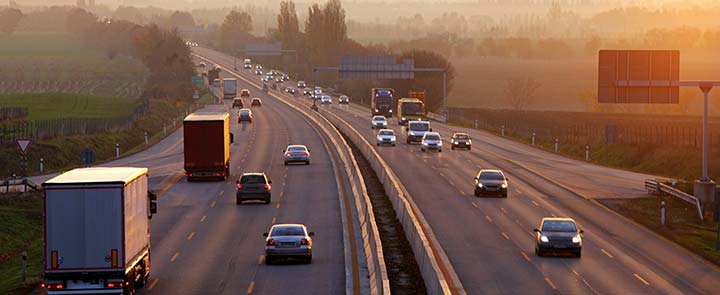
As the world’s second largest country, Canada is a road-tripper’s dream. Hiring a car or camper van offers one of the best ways to see this fantastic country, letting you experience its many cultures, cosmopolitan cities and dramatic natural scenery. The country’s sheer size means must plan your route and prepare for the great distances you’ll cover. A good knowledge of the rules for driving in Canada will help too.
Roads in Canada
Canada’s roads stretch over one million kilometres, including the Trans-Canada Highway, the fourth longest road in the world. Roads in Canada are maintained to a high standard by provincial governments and there are few toll roads (most of which are found on a handful of bridges and near the US border).
Given the size and geography of the country, the road network is much denser in the south of the country and around major cities like Toronto. Outside of major cities, you’ll often be the only vehicle on the road for miles.
Here are the main types of roads in Canada:
Local roads
Canada’s local roads are intended to provide access to private property and are usually found in suburban and rural areas. They have low traffic speed and must have at least one sidewalk.
Collector roads
Collector roads are designed for connecting traffic to larger arteries. They will be signalled at intersections with arterial roads and will have sidewalks on both sides of the road.
Minor arterial roads
This kind of road is principally designed for facilitating traffic movement, although will provide access to some types of property. They do not have ‘stop’ signs – instead, intersections are controlled by traffic lights. They also have sidewalks on both sides of the thoroughfare.
Major arterial roads
These roads are primarily designed for traffic movement and are subject to access controls (meaning you’ll have to wait at light or at a line before you can enter the flow). The speed limit is normally 50-60km/h and there are usually sidewalks on both sides of the road.
Expressways
Expressways are the equivalent of British motorways. The speed limit is typically 80-100 km/h. There is no property access and cyclists and pedestrians are prohibited from entering them.
How to drive in Canada
Canada is relatively easy to navigate by car. Canadians are well known for their politeness and this extends to their driving habits too. They have a strong focus on safety and defensive driving, meaning you’re unlikely to encounter much erratic behaviour.
You’ll be likely to end up hiring an automatic transmission car in Canada rather than the kind of manual vehicle you’d be used to in Europe (that said, it’s possible to find manual cars, and you might prefer one if driving in winter). However, most drivers get used to automatic driving without too much trouble and it can make life easier when you’re travelling long distances.
If you’re planning on road-tripping across Canada, do not underestimate the distances involved. Make sure you’ve planned a sensible route, have enough fuel, food and water. If you’re driving in winter, you’ll want to take even more precautions in case of a breakdown (more on winter driving below). It’s also important to remember that wild animals like moose and elks wandering onto the road is a real issue in Canada, especially at night - so drive cautiously.
What side of the road does Canada drive on?
Like most of the world, Canadians drive on the right-hand side of the road. If this is your first time driving on the right, spend some time getting used to it on smaller side roads.
Who has right of way?
There are some differences in how the right of way works in Canada. Firstly, lights at intersections: when you’re at a red light at an intersection, you are allowed to turn right – but must proceed with caution and watch out for pedestrians (this is true for everywhere except Montreal). There are also two types of green light in Canada, whereas a flashing green light means you have the right of way to turn left.
If you come to a four-way crossroad or an intersection without traffic lights – which is common in rural areas – it is the driver to the right who has the right of way.
What is the speed limit in Canada?
Speed limits in Canada are measured in kilometres per hour, rather than miles per hour. Speed limits signs are posted on all roads.
- In urban areas away from major arteries, the speed limit will normally be 50km/h unless otherwise stated
- For rural roads outside of towns, the speed limit will be 60-80 km/h
- The maximum speed limit on highways will be 80-100 km/h (and the minimum limit is 60 km/h)
Driving in adverse conditions in Canada
Canada is famous for its cold, snowy winters – it can drop as low as -40°C in some parts of the country. So, if you plan on driving in Canada in winter, it’s essential to take extra precautions:
- Ensure your hire car has chains or winter tyres (in some provinces this is a legal requirement)
- Bring paper maps in case your GPS fails, snow scrapers and a torch with spare batteries
- Dress appropriately – warm clothes are essential
- Bring a sleeping bag just in case you do have a breakdown – having a warm sleeping bag could be a lifesaver
- Bring a heater – many Canadians carry heaters in their cars in winter to make driving more bearable
- Plan your trip and tell people where you are going
- Drive very defensively, watching out for black ice and other hazards and avoid driving at night
‘Safety first’ is the rule
Canadian driving law is heavily focused on safety, so bear in mind that:
- There are stiff penalties for driving under the influence. The limit is 80 mg of alcohol per 100 ml of blood
- Safety belts must be worn at all times
- You cannot use a mobile phone while driving, but you can use a hands-free system
Driving hazards in Canada
As noted above, winter is the most difficult time for driving in Canada and you should take precautions for snow, ice and glare.
That said, most tourists will likely to visit Canada during the warmer months. While summer is much safer for driving, you should still take precautions:
- Prepare for the heat - If you’ll be driving very long distances, always stock up on bottled water since Canada can get very hot in the height of summer.
- Food and fuel - Make sure you have snacks and spare fuel for long legs of your journey.
- Severe weather - Thunderstorms can build up and torrential rain may be a hazard for visibility and control.
- Falling asleep at the wheel - Falling asleep at the wheel is a risk everywhere, but this risk is heightened when driving on long, empty and straight roads common in Canada.
- Wild animals - Watch out for wild animals like moose, elk or even bears crossing the road.
If you do get into any trouble while driving in Canada, check if anyone is injured. If so, call the emergency services on 911. Otherwise, you should immediately get in touch with your car rental company, who will advise you on what to do next.
Canada driving tips
While driving in Canada it’s worth preparing for some of the country’s other idiosyncrasies. These include:
- Brushing up on your French - In Quebec, many road signs are only be written in French.
- School buses - Whenever a yellow school bus stops in Canada and flashes its red lights, all traffic must stop – in either direction.
- Child seats - These must be used for any passenger weighing less than 20kg.
- Headlights - In Novia Scotia you must always have your headlights turned on, even during the day.
More information about driving in Canada
Canada offers some of the most dramatic and jaw-dropping driving opportunities in the world.
For more information, visit:
- Transport Canada: The government’s official site for driving law and news
- Canada Border Services Agency: Useful information on waiting times and requirements if you plan on crossing into the US
- The Canada weather website: Includes alerts and updates on conditions
Don’t forget your excess insurance
Collision Damage Waiver (CDW) and Supplementary Liability Insurance (SLI) can cost as much as $30 a day if you buy your cover from your rental company. Save money and protect yourself with car rental excess waiver before your flight out by purchasing an annual Worldwide Plus Car Hire Excess Insurance policy from insurance4carhire.
Do you need to make a claim?
If you’ve suffered damage to or loss of your hire vehicle due to theft, and you’ve purchased an insurance4carhire hire car excess insurance policy, we’re ready to help.
Related Guides

A Guide to Car Hire Costs
We like to think our car excess insurance is nice and straightforward. Your car rental agreement, however, might not be so easy to understand. With this in mind, we’ve put together a guide to car hire costs.

Top Tips for Driving a Hire Car Abroad
Having a hire car on holiday could save you the hassle of sorting out transfers. Not only that, it offers you the freedom to really explore and get to grips with your holiday destination...

A Guide to Car Hire from the Airport
There are thousands of car rental desks across airports round the world, competing against each other in small spaces. In this guide, we’ll explore whether it could be more beneficial to leave the airport before hiring a car for your trip.


